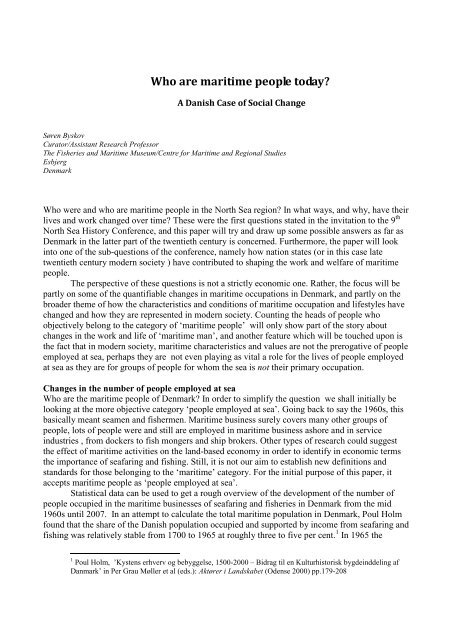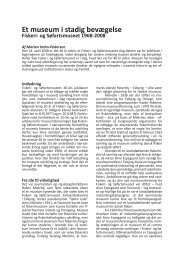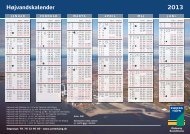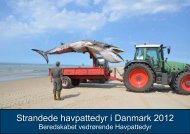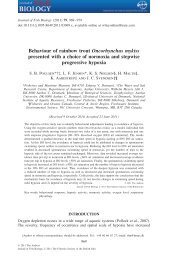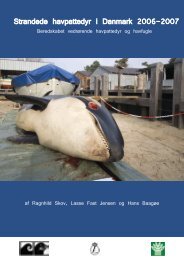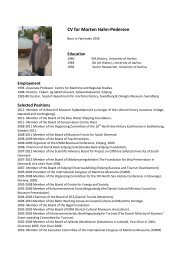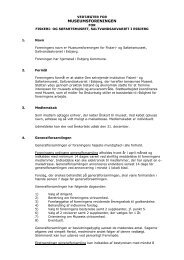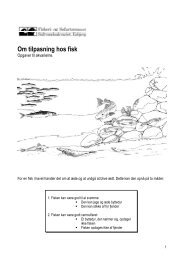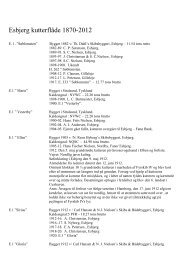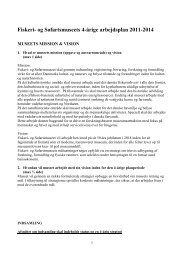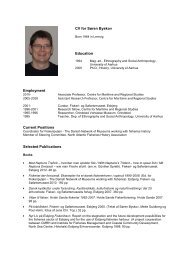Who are maritime people today? - Fiskeri- og Søfartsmuseet
Who are maritime people today? - Fiskeri- og Søfartsmuseet
Who are maritime people today? - Fiskeri- og Søfartsmuseet
Create successful ePaper yourself
Turn your PDF publications into a flip-book with our unique Google optimized e-Paper software.
Interestingly, the same town which in this way lost the largest number of fishermen in therestructuring of the fisheries sector also became home to the most important new industryemploying <strong>people</strong> at sea, namely the offshore oil and gas industry. To what extent this industrybecame manned by <strong>people</strong> from Esbjerg, who otherwise would have become fishermen, is ahypothetical question, but it may be noted that features of employment which were non-existent inthe fisheries, could be found in the offshore business. Work in the offshore sector was done at sea,but while a fisherman never knew the length in days of any given catch journey, the offshoreemployee had well-defined periods of work and leisure time. And while the fisherman’s pay-chequecould vary considerably according to prices achieved at the fish auction, the wage for the offshoreemployee was known and secure just like in any shore-based industry. Moreover, the offshoreindustry seeks and rewards education among its employees , and after the boom years in the early1980s it became an attractive sector in which various kinds of craftsmen and engineers could pursuea c<strong>are</strong>er. Within the fisheries sector, status had always been much more rigid from the outset, therewould be successful and less successful fishermen, but they would all remain fishermen.To sum up, the amount of <strong>people</strong> employed at sea in Denmark has experienced a declinesince the 1960s. This development has turned earning a living at sea into something of a nicheoccupation. Or to be more precise, there <strong>are</strong> at least three separate niches in the present day Danish<strong>maritime</strong> labour market, each of them giving its main attention to the modern demand forprofessionalisation and development of individual skills. Each of these strands varies in its level ofsuccess, the offshore oil and gas industry being ahead of the others. The number of fishermen iscontinuing to go down, and even in the active commercial fishing ports on the west coast, wheresocial values still give status to fishermen, it is difficult for vessel owners to recruit young <strong>people</strong>.Even though the fleet of gill-netters from the large west coast port of Hvide Sande was reducedfrom more than 100 vessels in 1983 to less than 30 in 2006, it has been increasingly difficult forvessel owners to find suitable Danes to recruit, and most vessels use unskilled Eastern Europeanlabour as deck-hand crew. The younger males among the local Danish work force were r<strong>are</strong>lyattracted to a working life on a fishing boat with all the potential sacrifices that it implied. Lack ofdaily contact with friends and relatives and lack of regular leisure time was a price they wereincreasingly reluctant to pay, and even if formal education as professional fisherman has beenavailable since 1995, the number of apprentices continuing as active fishermen after completingtheir studies is still low. These apprentices often now do not come from fishing families and so itbecomes difficult for them to integrate their non-<strong>maritime</strong> social background into life as a fishermanwith all the uncertainties that it contains. Earlier on, seasickness and the hard work could betolerated because the status and pay was relatively high, but in the modern labour market a typicalfisherman will have difficulties maintaining an income higher than the average skilled workerashore. 13Maritime occupations , change and evolutionThe opposite development has taken place in the new line of <strong>maritime</strong> occupation in the offshore oiland gas industry. In this highly technol<strong>og</strong>ical and capital intensive sector crew members on boardthe platforms <strong>are</strong> required to deliver highly specialised service outputs on time which in turnrequires them to have high educational and professional standards. Consequently, companies tend topay accordingly and wages <strong>are</strong> comparatively high signalling that human resources <strong>are</strong> seen as a13 Issues of recruiting for the fishing fleet <strong>are</strong> discussed in Byskov, Viljen til fiskeri, p.61f and S. Byskov,’Hvad blev der af Esbjerg-fiskeriet? Forandringer i fiskeriet fra Esbjerg 1965-2005’ in M. Hahn-Pedersen(ed.), Sjæk’len 2004. Årb<strong>og</strong> for <strong>Fiskeri</strong>- <strong>og</strong> Søfartsmuseet – Saltvandsakvariet, Esbjerg 2005, pp. 9-26
decisive factor for the success of companies in the sector. 14 Moreover, when it comes to recruitingskilled labour the offshore industry has the advantage of being an industry which in many respectsis similar to land based industries. The actual work takes place at sea, but the overall framework is aproduction design where core functionalities, demands, and standards for quality and delivery <strong>are</strong>parallel to a land based industrial facility. In other words, in the offshore sector it is expected thatemployees maintain a close knowledge of general industrial production and work processes andvalues. From a recruiting point of view this is a positive feature because it lets the professional workforce preserve competences within skilled crafts and engineering, which have a reasonable chanceof being transferable to land based industries in case the individual wants a change in c<strong>are</strong>er.In this respect, seafaring and fisheries at the outset <strong>are</strong> different from the offshore sector inthat they each have separate terms of reference ie. sea-transport/ navigation and fish -catchingwhich <strong>are</strong> not so easily comp<strong>are</strong>d to other sectors. Both these sectors in Denmark have traditionallyworked by recruiting a large part of their labour within established fishing or seafaringcommunities, but during the last decades this has become increasingly difficult due to thehom<strong>og</strong>enisation created by the educational demands of modern society and the break-up ofge<strong>og</strong>raphically separate <strong>maritime</strong> communities.Earlier, the extraordinary pattern of work and leisure time which made life as a seaman sodifferent from land based employment, tended to appeal mostly to young <strong>people</strong> who were alreadyacquainted with them through their cultural or family background in the <strong>maritime</strong> communities.Interestingly, in the last quarter of the 20 th century these conditions changed so much that a c<strong>are</strong>eras seaman became more widely appealing to young <strong>people</strong> and in this respect similar to conditionsin the offshore oil and gas sector. Instead of having to sign on a ship for say six months and lookingforward to one or two months leave, the dominant principle of labour organisation in the merchantmarine since the 1990s for Danish seamen has became ‘one job, two individuals’. This has putmany seamen in the situation of sharing the responsibility on board a particular vessel with acolleague with whom he or she makes regular shifts lasting ,for instance, between two and threemonths. This in turn is also comparable to the offshore sector, though working periods here <strong>are</strong>typically shorter, well under one month, but also following the principle of a 50/50 distribution ofwork and leisure/holiday time. The predictability vis-à-vis family and leisure time means that<strong>today</strong>’s <strong>maritime</strong> <strong>people</strong> <strong>are</strong> able to take part in all the normal social relations, community life, andeven the c<strong>are</strong> and upbringing of children in ways which for most types of seamen were not possiblebefore. Also on the positive side of this development is the fact that the standard of living on boardships in the merchant marine has improved considerably, and companies have seemingly, in linewith the reduced and flexible crew sizes, heightened the quality of facilities for the crew with bettercabins, possibilities for exercise, etc. 15One could argue that the deal between seamen and companies in this respect has been thatwhen 50 per cent of the full-time seaman’s time is spent at home on leave, the company can expect100 per cent dedication from each seaman in the working periods when he or she is signed on ship.Technol<strong>og</strong>ical developments in port facilities has made loading and unloading extremely fast formost types of vessels, most notably container ships, and consequently crew members very r<strong>are</strong>lywill have a day off when signed on active service. Officers and ordinary seamen thus have verylong working hours and companies will be expecting high levels of flexibility and work dedication.When shipping companies invest in Danish seamen with a high level of education, they will expectthe result to be competent and dedicated crew members.14 This is not based on statistics, but something which is widely accepted as the situation in the offshore sector.Indirect indications to this is given in Hahn-Pedersen & Jensen, Afledt effekt…, p. 4515 Jeppesen et al, Containere & koncentration, p.180
So, what characterises employees in the merchant marine and the offshore sector alike <strong>are</strong>values of professionalism, dedication, and flexibility. Maritime occupation is not so much a choicefor life anymore, and some of the cultural and characteristic life style factors earlier connected with<strong>maritime</strong> life have become less dominant and instead <strong>are</strong> replaced by professional business valueswhich make these <strong>maritime</strong> occupations more compatible with dominant parts of the rest of theskilled, private labour market. A considerable proportion of the professionals employed in these<strong>maritime</strong> sectors could rather easily adapt to positions as managers or skilled workers in othersectors, and this feature is perhaps what characterises the <strong>maritime</strong> work force <strong>today</strong>; they onlyremain <strong>maritime</strong> as long as their jobs <strong>are</strong> compatible with the rest of their private and professionallife strategies. Other sectors of the labour market can use their qualifications, and the end effect isthat a c<strong>are</strong>er at sea more than ever before seems to be giving the individual a competence in relationto c<strong>are</strong>er shifts.Many things seem to point to the fact that these characteristics <strong>are</strong> not valid for fishermen.Fishing is not easily conformed into regular schedules of working periods with fixed salaries. In apopular phrase fishermen <strong>are</strong> often described as ‘the last full time hunters in the modern world’, andno doubt fishermen themselves like to look at their occupation as something quite distinctlydifferent from the rest of the labour market. Nevertheless, when one looks at the Danish experiencethe type of fisherman developing in the 21 st century, within a very diminished fishing labourmarket, seems to be an employee who no longer accepts quite the same uncertainties that hispredecessors did. As in seafaring, there <strong>are</strong> positive signs that vessel owners, who by the wayconstitute a substantial part of the active fishermen 16 ,must secure future fishermen a range of rightsand advantages in order to recruit competent crew members. The most effective and ambitiousfishing vessels in the Danish fishing fleet thus have developed more modern terms of employmentfor their crew, the most important being fixed minimum pay and a regular scheme of leave andwork, so that a total crew of for instance five fishermen operate a fishing vessel with three menbeing signed on for each journey and two staying ashore. Furthermore, the most attractive fishingvessels for the able fisherman <strong>are</strong> those modern vessels built within the last ten years at Danish shipyards in which ship construction gives ,through a range of measures, priority to health and safety atwork. Improved vessel stability, reduced engine noise and vibration, shelter in work stations againstwind and waves, and a general heightening of the quality of crew facilities and habitation <strong>are</strong>among the important changes. 17Finally, even if fisheries traditionally have been an uncertain line of business with catchesdepending on skill, equipment, and a bit of luck, it has now in many countries become easier forskippers to plan their annual pattern of activity. Thanks to the introduction of individual transferablequotas (ITQ) vessel owners <strong>today</strong> have a better possibility to secure individual fishing rights thatmatch each vessel and which will provide a turnover in line with the investment level for the vesseland crew. Thus, for the individually hired fisherman, the situation can be more predictable inrelation to the amount of fish that will be available to the particular vessel each year. Even if it maytake away some of the original charm and unpredictability of the fisheries it is more likely to satisfyevery fisherman’s ambition to reduce the risk of coming out of a given year with too little gain.Moreover, the wages of the crew members no longer depends on the catch of each fishing trip. Bythe end of each year the value of the vessel’s total catches will be distributed equally to the crewmembers without regard to exactly who took part in the most successful fishing trips and who tookpart in the not so successful trips. Just like other <strong>maritime</strong> occupations, the fisheries <strong>are</strong> developinginto a branch of work in which the individual fisherman can fulfil his demands for leisure time, a16 The number of vessels above 5 tonnes in 2007 was 1,068 with the total number of fishermen being 3,450[4,400 registered professional fishermen, see note 3 above]17 Byskov, Viljen til fiskeri, p.58f and 75ff
Examples <strong>are</strong> the large groups of <strong>people</strong> engaged in leisure sailing activities and maintenance ofobsolescent and historic vessels. These same <strong>people</strong> <strong>are</strong> active participants in discussions about portdevelopment in Denmark, arguing with persistence against modernisation of port <strong>are</strong>as into non<strong>maritime</strong>functions.Likewise, this type of discourse involves small and medium scale fishermen who <strong>are</strong> nolonger able to compete with modern vessels on fully commercial terms. They have difficultiesrecruiting young <strong>people</strong> and they have to buy ITQs in order to remain in business, but they <strong>are</strong>arguing heavily against these new regulations and use their status as be<strong>are</strong>rs of a cultural fishingheritage in their arguments. Organisations, for instance, heavily involved in the preservation ofolder vessels or campaigning on environmental and cultural issues related to fisheries <strong>are</strong> promotinga <strong>maritime</strong> cultural heritage which is in danger of being lost . 18Various interest groups consisting of what might be designated as some of the selfconsciously<strong>maritime</strong> <strong>people</strong> of Denmark <strong>are</strong> calling on the public to increase their opportunities toremain actively <strong>maritime</strong>. I have earlier introduced the concept of recreationalisation to signify thegrowth in a Danish context of the importance of recreational, natural, cultural , historical, or othersymbolic or immaterial values applied to the Danish coasts. 19 This process can clearly be traced inthe complexity of the <strong>maritime</strong> world in present-day Denmark. While <strong>people</strong> working asprofessionals in the <strong>maritime</strong> occupations of seafaring, fisheries and offshore oil and gas operations<strong>are</strong> engaged in work processes which resemble the general conditions in the modern labour market,a process of recreationalisation has taken place concerning the potential of the <strong>maritime</strong> realm toprovide experiences or symbolic meaning to <strong>people</strong> as <strong>are</strong>as of cultural value and heritage. In thisway, a possible reply to the topic of this paper would be to change the headline from ‘who’ to‘what’, meaning ‘what is the role of <strong>maritime</strong> values and experience for <strong>people</strong> in Denmark <strong>today</strong>?’The answer could be a mix between clear cut economic and social value on the one hand and on theother hand a range of living cultural representations and heritage linked to <strong>people</strong>’s sympathiestowards the <strong>maritime</strong> world of history, ships, ideas, and <strong>people</strong>. In any case, <strong>maritime</strong> values andexperience features will live on, while <strong>people</strong> employed at sea in modern society continue to dotheir work!18 http://www.levendehav.dk/ [The Danish Society for a Living Sea], http://www.ts-skib.dk/ [Association forpreserving older common vessels]19 S. Byskov, Dansk kystkultur under forandring. Kystlandskab, kulturhistorie <strong>og</strong> naturforvaltning i det 20.århundrede, Esbjerg 2007 [With summary: ’Changes in Danish coastal culture. Coastal landscape, culturalhistory, and nature management in the 20th century’]


